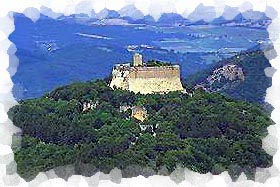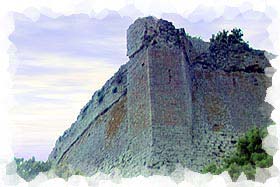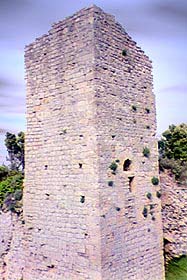Rocca Sillana
 |
 |
| Aerial view. | The characteristics leaning turrets, situated to the four angles of the walls. |
The Fortress of Sillana, Sillano or Silano is situated at the oriental extremity of the town territory of Pomarance (Pisa). The one who comes from Volterra once passed the town chief have to follow the road for S.Dalmazio (Itinerary of the Ruins) where there's the indications for the Fortress and the Church along the road that conducts to Lanciaia. From Florence follow the speedway Florence-Siena 'til the exit 'Colle Valdelsa Sud', then follow the indications for Casole D'Elsa, Monteguidi and finally Montecastelli. A little afterwards passed the last crossing you will find on the right the indication for the Fortress just before S.Dalmazio. The Fortress of Sillano is reachable only by foot after following a path in the wood.
More Photos
Page of the Parish Church of Sillano
The mighty Fortress of Sillano rise on a 530 meters high position to dominate a vast territory that includes the provinces in Siena, Pisa and Grosseto. These position has been always strategically important to check the valley of the river Cecina and the surrounding minor valleys, so much that the legend wants to date the origin of the small fortress in Roman times, on the occasion of the civil war between Mario and Silla, and that from this last derive its name (Silla-Sillano). The historical testimonies came up to us confirms that the Fortress is of a very ancient epoch: The tower and the inside part of the enclosure would have to go back to the 13th century while the external bastionated perimeter, performed to reinforcement of the preexisting wall curtains, can be dated certainty to the second half of 1400th.
 |
| The most ancient part of the fortress: the watch tower of the 11th century. |
The historians attribute without doubts the paternity of the project to the famous architect Giuliano da Sangallo and the fortress is without doubt one of the more ancient and most beautiful examples of the new military architectural conception of the historical period that marked the passage from the crossbow to the fire weapons, with the consequent development of the defense systems.
Before reaching the real fortress we meet the first defenses around thirty meters under the vertex of the hill. They were constituted by a strengthened gate with annexed a tower, both build in bricks, on the road that conducted under the walls of the principal fortress. Today only few traces of both remains. Reached the summit of the hill we find us under the thick bastionated enclosure of the fortress. Particular are the four leaning turrets built on the angles of the quadrilateral and the curvature of the curtain. The lower part of the walls is built in stone, the highest in bricks. The fortification remained abandoned for centuries, nevertheless externally we can see it still under good conditions. Inside the show is unfortunately different: the courtyard is invaded by the vegetation and the plan of stamping results notably anymore high due to the sediment deposits. Only thanks to the recent works of restoration, still today in action, are returning to the light some inside halls, surely destined at the time as stores and barracks for the garrison. Over all soar the ancient nucleus of the fortress: a watch tower in stone of square form with the gate of access at the level of the first floor, now walled but still well visible. Once climbed on the bastions, watching out because the parapet has disappeared and the zone is particularly windy, we can easily understand the strategic importance of the position and enjoy us a splendid sightseeing: in the clear days the look can space up to the sea.
| More Photos |
| Back to Homepage |
| Back to Castles Index |